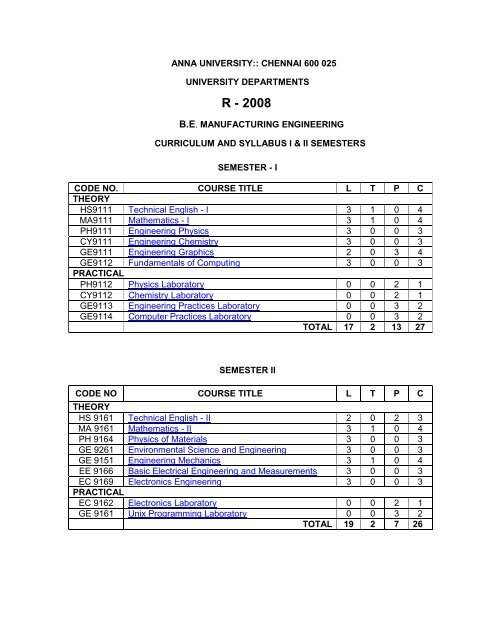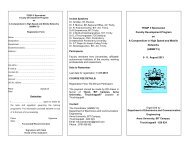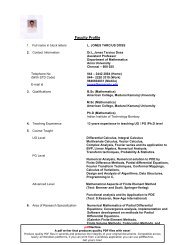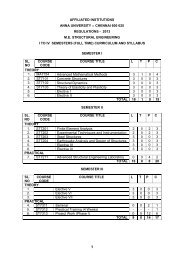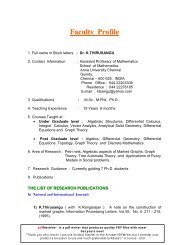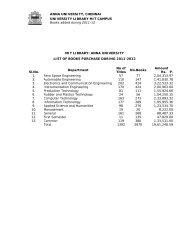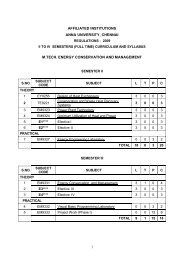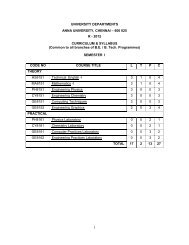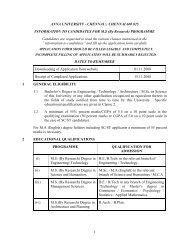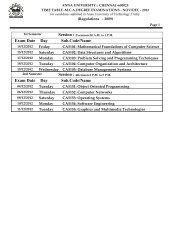MANUFACTURING I & II.pdf - Anna University
MANUFACTURING I & II.pdf - Anna University
MANUFACTURING I & II.pdf - Anna University
Create successful ePaper yourself
Turn your PDF publications into a flip-book with our unique Google optimized e-Paper software.
ANNA UNIVERSITY:: CHENNAI 600 025<br />
UNIVERSITY DEPARTMENTS<br />
R - 2008<br />
B.E. <strong>MANUFACTURING</strong> ENGINEERING<br />
CURRICULUM AND SYLLABUS I & <strong>II</strong> SEMESTERS<br />
SEMESTER - I<br />
CODE NO. COURSE TITLE L T P C<br />
THEORY<br />
HS9111 Technical English - I 3 1 0 4<br />
MA9111 Mathematics - I 3 1 0 4<br />
PH9111 Engineering Physics 3 0 0 3<br />
CY9111 Engineering Chemistry 3 0 0 3<br />
GE9111 Engineering Graphics 2 0 3 4<br />
GE9112 Fundamentals of Computing 3 0 0 3<br />
PRACTICAL<br />
PH9112 Physics Laboratory 0 0 2 1<br />
CY9112 Chemistry Laboratory 0 0 2 1<br />
GE9113 Engineering Practices Laboratory 0 0 3 2<br />
GE9114 Computer Practices Laboratory 0 0 3 2<br />
TOTAL 17 2 13 27<br />
SEMESTER <strong>II</strong><br />
CODE NO COURSE TITLE L T P C<br />
THEORY<br />
HS 9161 Technical English - <strong>II</strong> 2 0 2 3<br />
MA 9161 Mathematics - <strong>II</strong> 3 1 0 4<br />
PH 9164 Physics of Materials 3 0 0 3<br />
GE 9261 Environmental Science and Engineering 3 0 0 3<br />
GE 9151 Engineering Mechanics 3 1 0 4<br />
EE 9166 Basic Electrical Engineering and Measurements 3 0 0 3<br />
EC 9169 Electronics Engineering 3 0 0 3<br />
PRACTICAL<br />
EC 9162 Electronics Laboratory 0 0 2 1<br />
GE 9161 Unix Programming Laboratory 0 0 3 2<br />
TOTAL 19 2 7 26
HS 9111 TECHNICAL ENGLISH I L T P C<br />
(Common to all branches of B.E. / B.Tech. Programmes) 3 1 0 4<br />
AIM:<br />
To help students specialising in the field of Engineering and Technology develop their<br />
proficiency in oral and written communication in Technical English.<br />
OBJECTIVES:<br />
1. To enable students improve their vocabulary and employ the words appropriately in<br />
different academic and professional contexts.<br />
2. To make students comprehend classroom lectures and technically oriented<br />
passages.<br />
3. To enable students develop suitable reading strategies that could be adopted while<br />
reading science related texts.<br />
4. To enable students acquire the ability to speak effectively in English in real life<br />
situations and work-related situations.<br />
5. To train students in academic and professional writing.<br />
UNIT I 9+3<br />
Vocabulary - using words in context - use of suffixes to form nouns from verbs and<br />
adjectives – adjectives, adverbs - matching words with meanings - Active and passive<br />
voices – tenses - simple present, present continuous - comparative adjectives –<br />
adverbial forms - Reading text: skimming for general information - specific details - note<br />
making - cloze reading – Listening and transferring of information from text to graphic<br />
forms - bar charts, flow-charts - Paragraph writing - descriptions using descriptive words<br />
and phrases - organising information - Role play - conversational techniques –<br />
discussions - oral reporting.<br />
UNIT <strong>II</strong> 9+3<br />
Vocabulary items - words with prefixes (“multi-“, “under-“) - Asking and answering<br />
questions, error correction - spelling and punctuation - Reading Comprehension -<br />
scanning for information – inferring meaning from context - Listening and guided notetaking<br />
- paragraph writing - using notes – giving suitable headings / subheadings for<br />
paragraphs – Comparing and contrasting using expressions of comparison - Discussion<br />
using creative ideas<br />
UNIT <strong>II</strong>I 9+3<br />
Compound nouns - negative prefixes – antonyms – Use of modal verbs – making<br />
sentences using phrases – tenses – simple past and present perfect - Reading and<br />
guessing meanings in context - Listening and note taking - Channel conversion from text<br />
to chart - Writing comparisons - making recommendations - coherence using discourse<br />
markers - Discussion - role-play (explaining and convincing)<br />
UNIT IV 9+3<br />
Expanding nominal compounds – words with multiple meanings – Error correction -<br />
prepositions - use of the prefix “trans-“ - compound adjectives - modal verbs to express<br />
probability - simple past and present prefect - Reading – prediction of content -<br />
understanding advertisements - scanning the text and comprehension check - Listening<br />
for details - Writing definitions – expression of use and purpose - Role-play – discussion<br />
- speculating about the future
UNIT V 9+3<br />
Formation of nouns, verbs and adjectives from root words – some useful phrases and<br />
expressions - cloze exercises - ‘If’ conditional clauses – gerunds (verbal nouns) -<br />
Reading for comprehension - intensive reading - Accuracy in listening – listening to<br />
discussion on specific issues - Group discussion - role-play (stating, discussing<br />
problems and proposing solutions) - Planning a tour - Writing an itinerary - Writing<br />
formal letters - letter to the editor<br />
LECTURE – 45 TUTORIAL – 15 TOTAL : 60 PERIODS<br />
TEXTBOOK:<br />
1. Department of Humanities and Social Sciences, <strong>Anna</strong> <strong>University</strong>, English for<br />
Engineers and Technologists, Vol. I and <strong>II</strong> (Combined Edition), Orient Longman, Pvt.<br />
Ltd., 2006.Themes 1 to 4.<br />
REFERENCE:<br />
1. Day, R.A, Scientific English, Second Edition, Hyderabad: Universities Press, 2000.<br />
2. Mitra, B.K, Effective Technical Communication: A Guide for Scientists & Engineers,<br />
New Delhi: Oxford <strong>University</strong> Press, 2006.<br />
3. Website: www.uefap.co.uk<br />
MA 9111 MATHEMATICS – I L T P C<br />
(Common to all branches of B.E. / B.Tech. Programmes) 3 1 0 4<br />
AIM:<br />
To make available the basic concepts of engineering mathematics, to prepare<br />
the student for new concepts to be introduced in the subsequent semesters and<br />
to provide the necessary mathematical skills that are needed in modeling<br />
physical processes by an engineer.<br />
OBJECTIVES:<br />
<br />
<br />
<br />
<br />
<br />
To develop the use of matrix algebra techniques this is needed by engineers for<br />
practical applications.<br />
To make the student knowledgeable in the area of infinite series and their<br />
convergence so that he/ she will be familiar with limitations of using infinite series<br />
approximations for solutions arising in mathematical modeling<br />
To familiarize the student with functions of several variables which is needed in<br />
many branches of engineering<br />
To introduce the concepts of improper integrals, Gamma, Beta and Error<br />
functions which are needed in engineering applications<br />
To acquaint the student with mathematical tools needed in evaluating multiple<br />
integrals and their usage
UNIT I MATRICES 9+3<br />
Characteristic equation – Eigenvalues and Eigenvectors of a real matrix – Properties of<br />
eigenvalues and eigenvectors – Cayley-Hamilton Theorem – Diagonalization of<br />
matrices – Reduction of a quadratic form to canonical form by orthogonal transformation<br />
– Nature of quadratic forms.<br />
UNIT <strong>II</strong> INFINITE SERIES 9+3<br />
Sequences – Convergence of series – General properties – Series of positive terms –<br />
Tests of convergence (Comparison test, Integral test, Comparison of ratios and<br />
D’Alembert’s ratio test) – Alternating series – Series of positive and negative terms –<br />
Absolute and conditional convergence – Power Series – Convergence of exponential,<br />
logarithmic and Binomial Series.<br />
UNIT <strong>II</strong>I FUNCTIONS OF SEVERAL VARIABLES 9+3<br />
Limit and Continuity – Partial derivatives – Homogeneous functions and Euler’s theorem<br />
– Total derivative – Differentiation of implicit functions – Change of variables – Jacobians<br />
– Partial differentiation of implicit functions – Taylor’s series for functions of two variables<br />
– Errors and approximations – Maxima and minima of functions of two variables –<br />
Lagrange’s method of undetermined multipliers.<br />
UNIT IV IMPROPER INTEGRALS 9+3<br />
Improper integrals of the first and second kind and their convergence – Evaluation of<br />
integrals involving a parameter by Leibnitz rule – Beta and Gamma functions –<br />
Properties – Evaluation of integrals using Beta and Gamma functions – Error functions.<br />
UNIT V MULTIPLE INTEGRALS 9+3<br />
Double integrals – Change of order of integration – Double integrals in polar coordinates<br />
– Area enclosed by plane curves – Triple integrals – Volume of Solids – Change of<br />
variables in double and triple integrals – Area of a curved surface.<br />
L: 45, T: 15, TOTAL: 60 PERIODS<br />
TEXT BOOKS<br />
1. Grewal B.S., Higher Engineering Mathematics (40 th Edition), Khanna Publishers,<br />
Delhi (2007).<br />
2. Ramana B.V., Higher Engineering Mathematics, Tata McGraw Hill Co. Ltd., New<br />
Delhi (2007).<br />
REFERENCES<br />
1. Jain R.K. and Iyengar S.R.K., Advanced Engineering Mathematics (3 rd Edition),<br />
Narosa Publications, Delhi (2007).<br />
2. Bali N., Goyal M. and Watkins C., Advanced Engineering Mathematics (7 th Edition),<br />
Firewall Media, New Delhi (2007).<br />
3. Greenberg M.D., Advanced Engineering Mathematics (2 nd Edition), Pearson<br />
Education, New Delhi (1998).
PH 9111 ENGINEERING PHYSICS L T P C<br />
(Common to ALL Branches of B.E. / B.Tech. Programmes) 3 0 0 3<br />
OBJECTIVE:<br />
To introduce the basic physics concepts relevant to different branches of Engineering<br />
and Technology<br />
UNIT I PROPERTIES OF MATTER 9<br />
Elasticity – Poisson’s ratio and relationship between moduli (qualitative) – Stress-strain<br />
diagram – factors affecting elasticity – bending of beams – cantilever – bending moment<br />
– theory and experiment of Young’s modulus determination – Uniform and non-uniform<br />
bending – I shaped girders – twisting couple – hollow cylinder – shaft – torsion<br />
pendulum – determination of rigidity modulus – moment of inertia of a body (regular and<br />
irregular).<br />
UNIT <strong>II</strong> ACOUSTICS AND ULTRASONICS 9<br />
Classification of sound – loudness and intensity – Weber-Fechner Law – standard<br />
Intensity and Intensity level – decibel – reverberation – reverberation time –– rate of<br />
growth and decay of sound intensity - derivation of Sabine’s formula – absorption<br />
coefficient and its determination – factors affecting acoustics of buildings : focussing,<br />
interference, echo, Echelon effect, resonance – noise and their remedies. Ultrasonics –<br />
production – magnetostriction and piezoelectric methods – detection of ultrasound –<br />
acoustic grating – Industrial applications – NDT - Ultrasonic method: scan modes and<br />
practice.<br />
UNIT <strong>II</strong>I THERMAL PHYSICS 9<br />
Thermal expansion - thermal stress – expansion joints – bimetallic strips - thermal<br />
conductivity – conductions in solids – Forbe’s and Lees’ disc methods – thermal<br />
insulation of buildings – Laws of thermodynamics – Otto and diesel engines and their<br />
efficiency – entropy – entropy of Carnot’s cycle – reverse Carnot’s cycle – refrigerator.<br />
UNIT IV APPLIED OPTICS 9<br />
Interference - Michelson interferometer: construction, working, determination of wave<br />
length and thickness – anti-reflection coating – air wedge and its application – Lasers –<br />
Einstein’s coefficients – CO 2 , Nd:YAG and semiconductor lasers - construction and<br />
working – applications – Optical fibres – classification (index & mode based) – principle<br />
and propagation of light in optical fibres – acceptance angle and numerical aperture –<br />
fibre optic communication system - active and passive sensors.<br />
UNIT V SOLID STATE PHYSICS 9<br />
Nature of bonding – growth of single crystals (qualitative) - crystal systems - crystal<br />
planes and directions – expressions for interplanar distance – coordination number and<br />
packing factor for simple structures: SC, BCC, FCC and HCP – structure and<br />
significance of NaCl, ZnS, diamond and graphite – crystal imperfections: point defects,<br />
dislocations and stacking faults.<br />
TOTAL : 45 PERIODS<br />
TEXT BOOKS:<br />
1. Palanisamy, P.K., Engineering Physics, Scitech Publications (P) Lt, 2006.<br />
2. Arumugam, M., Engineering Physics, Anuradha Publ., 2000.
REFERENCES:<br />
1. Gaur R.K., and Gupta, S.L Engineering Physics, Dhanpat Raj Publ., 2003.<br />
2. Sankar B.N., Pillai.S.O., Engineering Physics, New age International (P) Ltd, 2007<br />
CY9111 ENGINEERING CHEMISTRY L T P C<br />
(Common to all branches of Engineering and Technology) 3 0 0 3<br />
AIM:<br />
To gain a sound knowledge of thermodynamics, phase rule, surface chemistry and<br />
catalysis, basic organic reaction mechanisms and principles and applications of<br />
spectroscopy and nanochemistry.<br />
OBJECTIVES:<br />
To make the student conversant with the<br />
Applications of second law of thermodynamics.<br />
Phase rule and various types of alloys<br />
Surface chemistry and its importance in adsorption and catalysis.<br />
Basic principles in organic reaction mechanisms and principles and applications<br />
of spectroscopy<br />
Nanochemistry and its applications<br />
UNIT I THERMODYNAMICS 9<br />
Statement of second law of thermodynamics – Clausius and Kelvin – definition of<br />
entropy – entropy change for a reversible process – entropy change for flow of heat in<br />
an irreversible process – entropy change for an isothermal expansion of an ideal gas –<br />
problems – entropy of phase transitions- problems – definition of free energy and work<br />
function – Gibbs Helmholtz equation – applications – problems – derivation of Maxwell<br />
relations – van’t Hoff isotherm and isochore – applications – problems – chemical<br />
potential – variation of chemical potential with temperature and pressure - significance.<br />
UNIT <strong>II</strong> PHASE RULE 9<br />
Phase rule – statements and explanation of the terms involved – condensed phase rule<br />
– construction of phase diagram – water system – sulphur system – phase rule for two<br />
component alloy systems- thermal analysis – eutectic system - Lead-Silver system –<br />
simple eutectic formation – Zinc-Magnesium alloy system – Iron-Carbon alloy systemsolved<br />
examples.<br />
UNIT <strong>II</strong>I SURFACE CHEMISTRY AND CATALYSIS 9<br />
Adsorption – types of adsorption – adsorption of gases on solids – adsorption isotherm –<br />
Freundlich and Langmuir isotherms – adsorption of solutes from solutions – applications<br />
– role of adsorption in catalytic reactions – ion exchange adsorption – basic principles in<br />
adsorption chromatography – Catalysis – classification – characteristics of catalysis -<br />
auto catalysis – enzyme catalysis – Michaelis – Mention equation – solid acid catalysis.
UNIT IV ORGANIC REACTIONS AND SPECTROSCOPY 9<br />
Electrophilic and nucleophilic, substitution and elimination reactions mechanisms – SN 1 ,<br />
SN 2 , E 1 , E 2 reactions – Electromagnetic spectrum – absorption of radiation – electronic<br />
transition – vibrational transition – rotational transition – intensities of spectral lines –<br />
beer-lamberts law –type of instrument used for absorption measurements –UV & visible<br />
spectroscopy, IR spectroscopy – principles of instrumentation and applications.<br />
UNIT V NANOCHEMISTRY 9<br />
Introduction to nanochemistry – preparations and properties of nanomaterials - nanorods<br />
– nanowires – nanotubes – carbon nanotubes and their applications – nanocomposites –<br />
sensors and electronic devices – nanochemistry in biology and medicines –<br />
nanocatalysis.<br />
TEXT BOOKS:<br />
TOTAL : 45 PERIODS<br />
1. Puri B.R., Sharma L.R. and Madhan S. Pathania, Principles of Physical Chemistry,<br />
Shoban Lal Nagin Chand & Co. Jalandar –2000.<br />
2. Jain P.C. and Renuka Jain, Physical Chemistry for Engineers, Dhanpet Rai &Sons,<br />
New Delhi, 2001.<br />
REFERENCES:<br />
1. Bahl B.S., Tuli G.D., and Arun Bahl, Essentials of Physical Chemistry, S. Chand<br />
& Company Ltd., New Delhi, 2004.<br />
2. Morrison R.T., & Boyd R.N., Organic chemistry, Prentice-Hall of India Private<br />
Limited, New Delhi, 1992.<br />
3. Sanyal S.N., Reactions, Rearrangements and Reagents Bharati Bhawan<br />
Publishers & Distributors New Delhi, 2006.<br />
4. G. B. Sergeev, Nanochemistry, Elsevier Science, New York, 2006<br />
GE 9111 ENGINEERING GRAPHICS L T P C<br />
(Common to All branches of B.E. / B.Tech. Programmes) 2 0 3 4<br />
OBJECTIVES:<br />
To develop in students the graphic skills that would enable them to communicate the<br />
concepts, ideas and design of engineering products<br />
To provide an exposure to the national/international standards related to technical<br />
drawings<br />
INTRODUCTION 2<br />
Importance of graphics in engineering applications – use of drafting instruments – BIS<br />
specifications and conventions – size, layout and folding of drawing sheets – lettering<br />
and dimensioning
UNIT I FREE HAND SKETCHING OF ENGG OBJECTS AND CONSTRUCTION<br />
OF PLANE CURVES 3+9=12<br />
Pictorial representation of engineering objects – representation of three dimensional<br />
objects in two dimensional media – need for multiple views – developing visualization<br />
skills through free hand sketching of three dimensional objects.<br />
Polygons & curves used in engineering practice– methods of construction– construction<br />
of ellipse, parabola and hyperbola by eccentricity method – Cycloidal and involute<br />
curves- construction - drawing of tangents to the above curves.<br />
UNIT <strong>II</strong> ORTHOGRAPHIC PROJECTION: PROJECTION OF POINTS, LINES<br />
AND PLANE SURFACES 6+9=15<br />
General principles of orthographic projection – first angle projection – layout of views –<br />
projections of points, straight lines located in the first quadrant – determination of true<br />
lengths of lines and their inclinations to the planes of projection – traces – projection of<br />
polygonal surfaces and circular lamina inclined to both the planes of projection<br />
UNIT <strong>II</strong>I ORTHOGRAPHIC PROJECTION: PROJECTION OF SOLIDS AND<br />
SECTIONS OF SOLIDS 6+9=15<br />
Projection of simple solids like prism, pyramid, cylinder and cone when the axis is<br />
inclined to one plane of projection –change of position & auxiliary projection methodssectioning<br />
of above solids in simple vertical positions by cutting plane inclined to one<br />
reference plane and perpendicular to the other and above solids in inclined position with<br />
cutting planes parallel to one reference plane – true shapes of sections<br />
UNIT IV DEVELOPMENT OF SURFACES AND INTERSECTION OF SOLIDS<br />
6+9=15<br />
Need for development of surfaces – development of lateral surfaces of simple and<br />
truncated solids – prisms, pyramids, cylinders and cones – development of lateral<br />
surfaces of the above solids with square and circular cutouts perpendicular to their axes.<br />
Intersection of solids and curves of intersection –prism with cylinder, cylinder & cylinder,<br />
cone & cylinder with normal intersection of axes and with no offset.<br />
UNIT V ISOMETRIC AND PERSPECTIVE PROJECTIONS 4+9=13<br />
Principles of isometric projection – isometric scale – isometric projections of simple<br />
solids, truncated prisms, pyramids, cylinders and cones – principles of perspective<br />
projections – projection of prisms, pyramids and cylinders by visual ray and vanishing<br />
point methods.<br />
COMPUTER AIDED DRAFTING (DEMONSTRATION ONLY) 3<br />
Introduction to computer aided drafting software packages and demonstration of their<br />
use.<br />
L:30 P:45 TOTAL: 75 PERIODS<br />
TEXT BOOKS:<br />
1. Bhatt,N.D, “Engineering Drawing”, Charotar Publishing House, 46 th Edition-2003<br />
2. Natarajan,K.V, “ A Textbook of Engineering Graphics”, Dhanalakshmi Publishers,<br />
Chennai, 2006 .
REFERENCES:<br />
1. Shah,M.B and Rana,B.C.,”Engineering Drawing”, Pearson Education,2005,<br />
2. Gopalakrishnan.K.R,. “Engineering Drawing I & <strong>II</strong>”, Subhas Publications 1998.<br />
3. Dhananjay,A.J., “Engineering Drawing with Introduction to AutoCAD”, Tata McGraw-<br />
Hill Publishing Company Ltd., 2008.<br />
4. Venugopal,K. and Prabhu Raja, V., “Engineering Graphics”, New Age<br />
International(P) Ltd.,2008.<br />
Codes from Bureau of Indian Standards<br />
1. IS 10711-2001: Technical Products Documentation – Size and Layout of Drawing<br />
Sheets<br />
2. IS 9609 (Parts 0 & 1 )-2001: Technical Products Documentation – Lettering<br />
3. IS 10714(Part 20)-2001 & SP 46 -2003: Lines for Technical Drawings<br />
4. IS 11669-1986 & SP 46-2003: Dimensioning of Technical Drawings<br />
5. IS 15021(Parts 1 to 4)-2001: Technical Drawings-Projection Methods<br />
Special points applicable to <strong>University</strong> Examinations on Engineering Graphics:<br />
1. There will be five questions one from each unit covering all units of the syllabus<br />
2. All questions will carry equal marks of 20 each making a total of 100<br />
3. Answer paper shall consist of drawing sheets of A3 size only. The students will be<br />
permitted to use appropriate scale to fit solutions within A3 size<br />
4. The examination will be conducted in appropriate sessions on the same day<br />
GE 9112 FUNDAMENTALS OF COMPUTING L T P C<br />
(Common to all branches of B.E. / B.Tech. Programmes) 3 0 0 3<br />
AIM:<br />
To introduce the basics of computing and the fundamentals of C programming.<br />
OBJECTIVES:<br />
• To introduce the fundamentals of computing systems.<br />
• To introduce the concepts of internet and WWW.<br />
• To teach programming in C.<br />
UNIT I 9<br />
Computer systems – Exploring computers – Inside the system – Processing data –<br />
CPUs – Types of storage devices - Operating systems basics – Networking basics.<br />
UNIT <strong>II</strong> 9<br />
The internet and the WWW – Internet services – connecting to the internet - Working<br />
with applications software – productivity software – graphics and multimedia – Data base<br />
Management systems – Creating computer program.
UNIT <strong>II</strong>I 9<br />
C programming fundamentals – compilation process – variables – Data types –<br />
Expressions – looping – decisions.<br />
UNIT IV 9<br />
Arrays - Working with functions – structures – character strings – pre processor.<br />
UNIT V 9<br />
Pointers – Dynamic memory allocation – linked list - Applications<br />
TEXT BOOKS:<br />
TOTAL: 45 PERIODS<br />
1. Peter Norton, “Introduction to Computers”, Sixth Edition, Tata McGraw Hill, 2007.<br />
2. Stephen G. Kochan, “Programming in C”, Third Edition, Pearson Education, 2007.<br />
REFERENCES<br />
1. Kernighan,B.W and Ritchie,D.M, “The C Programming language”, Second Edition,<br />
Pearson Education, 2006<br />
2. Ashok N. Kamthane, “Computer programming”, Pearson Education, 2007.<br />
3. Kenneth A. Reek, “Pointers on C”, Pearson Education, 2007.<br />
4. Dromey,R.G, “How to solve it by Computer”, Pearson Education, 2007.<br />
PH 9112 PHYSICS LABORATORY L T P C<br />
(Common to ALL Branches of B.E. / B.Tech. Programmes) 0 0 2 1<br />
1. Torsional Pendulum- Determination of rigidity modulus of wire and moment of<br />
Inertia of disc.<br />
2. Non-uniform bending - Determination of Young’s modulus.<br />
3. Lees’ disc- Determination of thermal conductivity of a bad conductor.<br />
4. Potentiometer - Determination of thermo e.m.f of thermocouple<br />
5. Air wedge- Determination of thickness of a thin sheet of paper.<br />
6. i. Optical fibre - Determination of Numerical Aperture and<br />
acceptance angle<br />
ii. Compact disc - Determination of width of the groove using laser.<br />
7. Acoustic grating - Determination of velocity of ultrasonic waves in liquids.<br />
8. Post office box - Determination of Band gap<br />
9. Spectrometer - Determination of wavelength using grating<br />
10. Viscosity of liquid- Determination of co-efficient of viscosity of a liquid by<br />
Poiseuille’s flow.<br />
TOTAL: 30 PERIODS
CY9112 CHEMISTRY LABORATORY L T P C<br />
(Common to all branches of Engineering and Technology) 0 0 2 1<br />
I. WEIGHING AND PREPARATION OF STANDARD SOLUTIONS<br />
1. Preparation of molar and normal solutions of the following substances oxalic<br />
acid, sodium carbonate, sodium hydroxide, and hydrochloric acid.<br />
2. Preparation of buffer solutions: borate buffer, phosphate buffer using<br />
Henderson equation.<br />
2. WATER ANALYSIS<br />
i) Determination of total hardness, temporary & permanent hardness of water by<br />
EDTA method.<br />
i) Determination of DO content by Winkler’s method.<br />
ii) Determination of alkalinity in a water sample.<br />
iii) Determination of chloride content of water sample by argentometric method.<br />
3. PH-METRY<br />
To find out the strength of given hydrochloric acid by sodium hydroxide.<br />
4. CONDUCTOMETRY<br />
i) Conductometric titration of mixture of acids<br />
ii) Conductometric precipitation titration using BaCl 2 - Na 2 SO 4<br />
5. POTENTIOMETRY<br />
i) Redox titration – Iron Vs. dichromate<br />
6. SPECTROPHOTOMETRY<br />
i) To determine max of a colored solution such as potassium permanganate.<br />
ii) To determine the iron content of an unknown solution (1,10- phenanthroline/<br />
thiocyanate method)<br />
7. FLAME PHOTOMETRY<br />
i) To determine sodium and potassium in water.<br />
8. VISCOMETRY<br />
i) Determination of molecular weight of a polymer<br />
9. WATER POLLUTION<br />
i) COD analysis of a waste water by dichromate method.<br />
10. KINETICS<br />
i) Determination of reaction rate constant of acid catalyzed hydrolysis of ester.
11. ADSORPTION<br />
i) Adsorption of acetic acid on activated charcoal.<br />
TOTAL: 30 PERIODS<br />
REFERENCES:<br />
1. A text of quantitative Inorganic Analysis, A. L. Vogel , ELBS London. 1995.<br />
2. Experiments in physical chemistry, D.P. Shoemarker and C.W. Gardad, McGraw Hill,<br />
London, 2001.<br />
GE 9113 ENGINEERING PRACTIES LABORATORY L T P C<br />
(Common to all Branches of B.E. / B.Tech. Programmes) 0 0 3 2<br />
OBJECTIVE<br />
To provide exposure to the students with hands-on experience on various basic<br />
engineering practices in Civil, Mechanical, Electrical and Electronics Engineering.<br />
GROUP – A (CIVIL & ELECTRICAL)<br />
1. CIVIL ENGINEERING PRACTICE 12<br />
Plumbing<br />
Basic pipe connections involving the fittings like valves, taps, coupling, unions,<br />
reducers, elbows and other components used in household fittings. Preparation of<br />
plumbing line sketches.<br />
Laying pipe connection to the suction side of a pump – inlet.<br />
Laying pipe connection to the delivery side of a pump – out let.<br />
Practice in mixed pipe connections: Metal, plastic and flexible pipes used in<br />
household appliances.<br />
Wood Work<br />
Sawing, planning and making common joints: T-Joint, Mortise and Tennon joint,<br />
Dovetail joint.<br />
Study<br />
Study of joints in door panels, wooden furniture<br />
Study of common industrial trusses using models.<br />
2. ELECTRICAL ENGINEERING PRACTICE 9<br />
Basic household wiring using switches, fuse, indicator – lamp etc.,<br />
Preparation of wiring diagrams
Stair case light wiring<br />
Tube – light wiring<br />
Study of iron-box, fan with regulator, emergency lamp<br />
GROUP – B (MECHANICAL AND ELECTRONICS) 15<br />
3. MECHANICAL ENGINEERING PRACTICE<br />
Welding<br />
Arc welding of butt joints, lap joints, tee joints<br />
Gas welding Practice.<br />
Basic Machining<br />
Simple turning, drilling and tapping operations.<br />
Machine assembly Practice.<br />
Study and assembling the following:<br />
Centrifugal pump, mixies and air conditioners.<br />
Demonstration on<br />
(a) Smithy operations like the production of hexagonal bolt.<br />
(b) Foundry operation like mould preparation for grooved pulley.<br />
4. ELECTRONIC ENGINEERING PRACTICE 9<br />
Soldering simple electronic circuits and checking continuity.<br />
Assembling electronic components on a small PCB and testing.<br />
Study of Telephone, FM radio, low-voltage power supplies.<br />
TOTAL: 45 PERIODS
GE 9114 COMPUTER PRACTICE LABORATORY L T P C<br />
(Common to all branches of B.E. / B.Tech. Programmes) 0 0 3 2<br />
AIM:<br />
The aim is to teach the use of computer applications related to office automation and to<br />
teach implementation of C programs.<br />
OBJECTIVES:<br />
• To introduce office automation software packages.<br />
• To teach the fundamentals in C programming.<br />
1. Simple OS commands and simple editors for file operations.<br />
2. Word processors for more complex operations, like formatting documents,<br />
creating tables and so on.<br />
3. Simple data base packages for creating and manipulating databases.<br />
4. Spread sheet packages for data preparation and analysis.<br />
5. Preparation of reports involving mathematical functions (Income Tax<br />
Statement, Mark sheets, Payroll etc.,)<br />
6. C Programs using one dimensional arrays.<br />
7. C Programs using multi-dimensional arrays and pointer data types.<br />
8. Programs using structures, nested structures and union.<br />
9. Programs using functions- recursive, non-recursive and Library functions.<br />
10. Programs for passing aggregate data types as parameters between<br />
functions.<br />
11. Programs for dynamic memory allocation / deallocation.<br />
12. Programs for self-referential structure – Implementing linked list.<br />
TOTAL: 45 PERIODS<br />
HS 9161 TECHNICAL ENGLISH <strong>II</strong> L T P C<br />
(For all branches of B.E. / B.Tech. Programmes) 2 0 2 3<br />
AIM:<br />
To help students specialising in the field of Engineering and Technology develop their<br />
proficiency in oral and written communication in Technical English.
OBJECTIVES:<br />
1. To enable students develop their critical thinking skills.<br />
2. To enable students develop higher order reading skills such as interpreting,<br />
evaluating and analysing.<br />
3. To enable students develop their active listening skills.<br />
4. To enable students participate successfully in Group Discussions.<br />
UNIT I 6<br />
Word formation using prefixes ‘self’ – modified cloze – contextual meanings -<br />
Sequencing words - future simple passive form - Predicting content – Intensive reading –<br />
interpreting advertisements – Listening and completing table – Writing extended<br />
definition – describing a process using sequence words – developing ideas into<br />
paragraphs – writing about the future.<br />
UNIT <strong>II</strong> 6<br />
Identifying objects and their use – word puzzles using words with suffixes – Prepositions<br />
– adverbs – structures that express purpose - adjectives – group discussion – Reading -<br />
skimming for content and analysis of style – modes of non verbal communication –<br />
Listening and categorising data in tables – Writing formal letter – writing paragraphs on<br />
various issues.<br />
UNIT <strong>II</strong>I 6<br />
Stress and intonation - Cause and effect expressions - Tense forms - simple past and<br />
past continuous - Different grammatical forms of the same word - Critical reading -<br />
guided note-making and evaluating content - Listening – guided note-taking –<br />
completing a table – Role-play – group discussion techniques - discussing an issue –<br />
offering suggestions – Sequencing jumbled sentences using coherence markers–<br />
Writing a report – Writing recommendations – Writing a letter of complaint.<br />
UNIT IV 6<br />
Numerical adjectives - Prepositions – use of intensifying prefixes – phrasal verbs -<br />
different grammatical forms of the same words – cloze exercise - Reading a text and<br />
evaluating the content - advertisements – analysing style and language - Listening and<br />
entering classified information – Intensive listening and completing the steps of a<br />
process - Role-play - Group discussion expressing opinions and convincing (agreeing<br />
and disagreeing) - Giving oral instructions – Descriptive writing - writing based on hints<br />
– writing argumentative paragraphs – formal letter writing – letter of application with<br />
biodata / CV Writing safety instructions - warnings and notices – preparing checklist –<br />
email communication.<br />
UNIT V 6<br />
Identifying problems, their causes and finding solutions using case studies – creative<br />
and critical thinking – levels of thinking – thinking strategies – brainstorming - analytical<br />
reasoning skills – evaluative essay – decision making – conflict resolution
English Language Lab<br />
(30 Periods)<br />
1. Listening: (10)<br />
Recognising English sounds – accents - listening & answering questions - gap filling -<br />
listening & note making - listening to telephonic conversations - listening to speeches.<br />
2. Speaking: (10)<br />
Pronouncing words & sentences correctly - word stress - conversation practice.<br />
3. Reading: (5)<br />
Cloze test - Reading and answering questions - sequencing of sentences.<br />
4. Writing: (5)<br />
Correction of errors - Blogging.<br />
TEXTBOOKS:<br />
TOTAL : 60 PERIODS<br />
1. Department of Humanities & Social Sciences, <strong>Anna</strong> <strong>University</strong>. English for Engineers<br />
and Technologists, Combined edition Vols. I & <strong>II</strong>. Chennai: Orient Longman, Pvt. Ltd.<br />
2006, Themes 5 to 8 (for Units 1 – 4)<br />
2. Sunita Mishra & C. Muralikrishna, Communication Skills for Engineers, Pearson<br />
Education, Second Impression, 2007. ( for Unit 5)<br />
REFERENCES:<br />
1. Ashraf, R.M, Effective Technical Communication, New Delhi: Tata McGraw Hill,<br />
2007.<br />
2. Thorpe, E & Thorpe, S, Objective English, New Delhi : Pearson Education, 2007.<br />
3. Joan Van, Emden, A Handbook of writing for Engineers, Cambridge <strong>University</strong><br />
Press, 1997<br />
4. Website: www.englishclub.com<br />
LAB REQUIREMENTS<br />
1. Teacher – Console and systems for students<br />
2. English Language Lab Software<br />
3. Tape Recorders
MA 9161 MATHEMATICS - <strong>II</strong> L T P C<br />
(Common to all branches of B.E. / B.Tech Programmes) 3 1 0 4<br />
AIM:<br />
To introduce the effective mathematical tools needed for solving engineering problems<br />
and to emphasize the underlying mathematical principles in specific situations<br />
confronting practicing engineers.<br />
OBJECTIVES:<br />
To make the student acquire sound knowledge of techniques in solving ordinary<br />
differential equations that model engineering problems<br />
To acquaint the student with the concepts of vector calculus, needed for problems in<br />
all engineering disciplines<br />
To develop an understanding of the standard techniques of complex variable theory<br />
so as to enable the student to apply them with confidence, in application areas such<br />
as heat conduction, elasticity, fluid dynamics and flow the of electric current<br />
To make the student appreciate the purpose of using transforms to create a new<br />
domain in which it is easier to handle the problem that is being investigated<br />
UNIT I DIFFERENTIAL EQUATIONS 9+3<br />
Method of variation of parameters – Method of undetermined coefficients – Homogenous<br />
equation of Euler’s and Legendre’s type – System of Simultaneous linear differential<br />
equations with constant coefficients.<br />
UNIT <strong>II</strong> VECTOR CALCULUS 9+3<br />
Gradient and directional derivative – Divergence and Curl – Irrotational and Solenoidal<br />
vector fields – Line integral over a plane curve – Surface Integral and Volume Integral -<br />
Green’s, Gauss divergence and Stoke’s theorems – Verification and Application in<br />
evaluating line, surface and volume integrals.<br />
UNIT <strong>II</strong>I ANALYTIC FUNCTION 9+3<br />
Analytic functions – Necessary and sufficient conditions for analyticity - Properties –<br />
Harmonic conjugates – Construction of analytic function - Conformal Mapping – Mapping<br />
1 2<br />
by functions w z c, az, , z - Bilinear transformation.<br />
z<br />
UNIT IV COMPLEX INTEGRATION 9+3<br />
Line Integral - Cauchy’s theorem and integral formula – Taylor’s and Laurent’s Series –<br />
Singularities – Residues – Residue theorem – Application of Residue theorem for<br />
evaluation of real integrals – Use of circular contour and semicircular contour with no<br />
pole on real axis.<br />
UNIT V LAPLACE TRANSFORMS 9+3<br />
Existence conditions – Transforms of elementary functions – Basic properties –<br />
Transforms of derivatives and integrals – Initial and Final value theorems – Inverse<br />
transforms – Convolution theorem – Transform of periodic functions – Application to<br />
solution of linear ordinary differential equations with constant coefficients.
TEXT BOOKS:<br />
L: 45, T: 15, TOTAL : 60 PERIODS<br />
1. Grewal, B.S. “Higher Engineering Mathematics”, Khanna Publications (2007)<br />
2. Ramana, B.V. “Higher Engineering Mathematics” Tata McGraw Hill (2007).<br />
REFERENCES:<br />
1. Glyn James, “Advanced Modern Engineering Mathematics, Pearson Education<br />
(2007)<br />
2. Jain R.K. and Iyengar S.R.K., Advanced Engineering Mathematics (3 rd Edition)<br />
Narosa Publications, Delhi (2007).<br />
PH9164 PHYSICS OF MATERIALS L T P C<br />
3 0 0 3<br />
OBJECTIVE:<br />
To introduce the essential principles of physics for chemical and related<br />
engineering applications.<br />
UNIT I MATERIALS PREPARATION AND PROCESSING 9<br />
Gibbs phase Rule – Phase Diagram – One component and multi component systems –<br />
eutectic – peritectic – eutectoid – peritectoid – invariant reactions – Lever Rule –<br />
Nucleation – homogeneous and heterogeneous nucleation – Free energy of formation of<br />
a critical nucleus – Nucleation rate – Experimental techniques of crystal growth –<br />
Czochralski Bridgman, Flux, Solution, Vapour, Sol-gel - hydrothermal – Epitaxy.<br />
UNIT <strong>II</strong> CONDUCTING MATERIALS 9<br />
Classical free electron theory of metals - Schrödinger wave equation - Time<br />
independent and time dependent equations. Physical significance of wave function,<br />
particle in a box ( in one dimension ) – electrons in a metal - Fermi distribution function<br />
– Density of energy states – effect of temperature on Fermi energy, Superconducting<br />
Phenomena, Properties of superconductors – Meissner effect and Isotope effect. Type<br />
I and Type <strong>II</strong> superconductors, High Tc superconductors – Magnetic levitation and<br />
SQUIDS.<br />
UNIT <strong>II</strong>I SEMICONDUCTING MATERIALS 9<br />
Origin of band gap in solids (qualitative) - Concept of effective mass of electron and<br />
hole – carrier concentration in an intrinsic semiconductor (derivation) – Fermi level –<br />
Variation of Fermi level with temperature – electrical conductivity – band gap<br />
determination – carrier concentration in n-type and p-type semiconductors (derivation) –<br />
variation of Fermi level with temperature and impurity concentration – Compound<br />
semiconductors – Hall effect – Determination of Hall coefficient – Solar cells.<br />
UNIT IV MAGNETIC AND DIELECTRIC MATERIALS 9<br />
Introduction to magnetic materials - Domain theory of ferromagnetism, Hysteresis, Soft<br />
and Hard magnetic materials – Anti-ferromagnetic materials – Ferrites, Giant Magneto<br />
Resistance materials, Electronic, Ionic, Orientational and space charge polarization –<br />
Internal field and deduction of Clausius Mosotti equation – dielectric loss – different
types of dielectric breakdown – classification of insulating materials and their<br />
applications.<br />
UNIT V NEW MATERIALS AND APPLICATIONS 9<br />
Introduction to Ceramics and its applications - Ceramic Fibres - Fibre reinforced<br />
Plastics – Fibre reinforced Metal – Metallic glasses – Shape memory alloys – Copper<br />
base alloys – Nickel – Titanium alloys - Sensors and Actuators – Range - Accuracy<br />
Determination –- Photo detectors, Bio-sensors, Scintillation detectors (Position<br />
sensitive) – Renogram – Computed Tomography Scan (CT Scan) - Magnetic<br />
Resonance Imaging (MRI) - Performance and Reliability testing.<br />
TEXT BOOKS:<br />
TOTAL : 45 PERIODS<br />
1. Kumar.J, Moorthy Babu. S and Vasudevan. S., Engineering Physics, Vijay Nicole<br />
Imprints, 2006.<br />
2. Palanisamy. P.K., Materials Science, Scitech., 2003.<br />
REFERENCES:<br />
1. Gaur. R.K. and Gupta. S.L., Engineering Physics, Dhanpat Rai Publication., 2003.<br />
2. Raghavan. V. Materials Science and Engineering, Prentice Hall of India, 2002.<br />
3. Arumugam, M, Biomedical Instrumentation, 2 nd Edition, Anuradha Agencies, 2003.<br />
GE9261<br />
ENVIRONMENTAL SCIENCE AND ENGINEERING<br />
(Common to all branches)<br />
L T P C<br />
3 0 0 3<br />
AIM<br />
To create awareness in every engineering graduate about the importance of<br />
environment, the effect of technology on the environment and ecological balance and<br />
make them sensitive to the environment problems in every professional endeavour that<br />
they participates.<br />
OBJECTIVE<br />
At the end of this course the student is expected to understand what constitutes the<br />
environment, what are precious resources in the environment, how to conserve these<br />
resources, what is the role of a human being in maintaining a clean environment and<br />
useful environment for the future generations and how to maintain ecological balance<br />
and preserve bio-diversity. The role of government and non-government organization in<br />
environment managements.
UNIT I ENVIRONMENT, ECOSYSTEMS AND BIODIVERSITY 14<br />
Definition, scope and importance of environment – need for public awareness - concept<br />
of an ecosystem – structure and function of an ecosystem – producers, consumers and<br />
decomposers – energy flow in the ecosystem – ecological succession – food chains,<br />
food webs and ecological pyramids – Introduction, types, characteristic features,<br />
structure and function of the (a) forest ecosystem (b) grassland ecosystem (c) desert<br />
ecosystem (d) aquatic ecosystems (ponds, streams, lakes, rivers, oceans, estuaries) –<br />
Introduction to biodiversity definition: genetic, species and ecosystem diversity –<br />
biogeographical classification of India – value of biodiversity: consumptive use,<br />
productive use, social, ethical, aesthetic and option values – Biodiversity at global,<br />
national and local levels – India as a mega-diversity nation – hot-spots of biodiversity –<br />
threats to biodiversity: habitat loss, poaching of wildlife, man-wildlife conflicts –<br />
endangered and endemic species of India – conservation of biodiversity: In-situ and exsitu<br />
conservation of biodiversity.<br />
Field study of common plants, insects, birds<br />
Field study of simple ecosystems – pond, river, hill slopes, etc.<br />
UNIT <strong>II</strong> ENVIRONMENTAL POLLUTION 8<br />
Definition – causes, effects and control measures of: (a) Air pollution (b) Water pollution<br />
(c) Soil pollution (d) Marine pollution (e) Noise pollution (f) Thermal pollution (g) Nuclear<br />
hazards – soil waste management: causes, effects and control measures of municipal<br />
solid wastes – role of an individual in prevention of pollution – pollution case studies –<br />
disaster management: floods, earthquake, cyclone and landslides.<br />
Field study of local polluted site – Urban / Rural / Industrial / Agricultural.<br />
UNIT <strong>II</strong>I NATURAL RESOURCES 10<br />
Forest resources: Use and over-exploitation, deforestation, case studies- timber<br />
extraction, mining, dams and their effects on forests and tribal people – Water<br />
resources: Use and over-utilization of surface and ground water, floods, drought,<br />
conflicts over water, dams-benefits and problems – Mineral resources: Use and<br />
exploitation, environmental effects of extracting and using mineral resources, case<br />
studies – Food resources: World food problems, changes caused by agriculture and<br />
overgrazing, effects of modern agriculture, fertilizer-pesticide problems, water logging,<br />
salinity, case studies – Energy resources: Growing energy needs, renewable and non<br />
renewable energy sources, use of alternate energy sources. case studies – Land<br />
resources: Land as a resource, land degradation, man induced landslides, soil erosion<br />
and desertification – role of an individual in conservation of natural resources – Equitable<br />
use of resources for sustainable lifestyles.<br />
Field study of local area to document environmental assets – river / forest / grassland /<br />
hill / mountain.
UNIT IV SOCIAL ISSUES AND THE ENVIRONMENT 7<br />
From unsustainable to sustainable development – urban problems related to energy –<br />
water conservation, rain water harvesting, watershed management – resettlement and<br />
rehabilitation of people; its problems and concerns, case studies – role of nongovernmental<br />
organization- environmental ethics: Issues and possible solutions –<br />
climate change, global warming, acid rain, ozone layer depletion, nuclear accidents and<br />
holocaust, case studies. – wasteland reclamation – consumerism and waste products –<br />
environment production act – Air (Prevention and Control of Pollution) act – Water<br />
(Prevention and control of Pollution) act – Wildlife protection act – Forest conservation<br />
act – enforcement machinery involved in environmental legislation- central and state<br />
pollution control boards- Public awareness.<br />
UNIT V HUMAN POPULATION AND THE ENVIRONMENT 6<br />
Population growth, variation among nations – population explosion – family welfare<br />
programme – environment and human health – human rights – value education – HIV /<br />
AIDS – women and child welfare – role of information technology in environment and<br />
human health – Case studies.<br />
TOTAL : 45 PERIODS<br />
TEXT BOOKS<br />
1. Gilbert M.Masters, “Introduction to Environmental Engineering and Science”, 2 nd<br />
edition, Pearson Education (2004).<br />
2. Benny Joseph, “Environmental Science and Engineering”, Tata McGraw-Hill, New<br />
Delhi, (2006).<br />
REFERENCE S;<br />
1. R.K. Trivedi, “Handbook of Environmental Laws, Rules, Guidelines, Compliances<br />
and Standards”, Vol. I and <strong>II</strong>, Enviro Media.<br />
2. Cunningham, W.P. Cooper, T.H. Gorhani, “Environmental Encyclopedia”, Jaico<br />
Publ., House, Mumbai, 2001.<br />
3. Dharmendra S. Sengar, “Environmental law”, Prentice hall of India PVT LTD, New<br />
Delhi, 2007.<br />
4. Rajagopalan, R, “Environmental Studies-From Crisis to Cure”, Oxford <strong>University</strong><br />
Press (2005).<br />
GE9151 ENGINEERING MECHANICS L T P C<br />
3 1 0 4<br />
OBJECTIVE :<br />
At the end of this course the student should be able to understand the vectorial and<br />
scalar representation of forces and moments, static equilibrium of particles and rigid<br />
bodies both in two dimensions and also in three dimensions. Further, he should<br />
understand the principle of work and energy. He should be able to comprehend the<br />
effect of friction on equilibrium. The student should be able to understand the laws of<br />
motion, the kinematics of motion and the interrelationship. The student should also be
able to write the dynamic equilibrium equation. All these should be achieved both<br />
conceptually and through solved examples.<br />
UNIT I BASICS & STATICS 9+3<br />
Introduction - Units and Dimensions - Laws of Mechanics – Lame’s theorem,<br />
Parallelogram and triangular Law of forces – Vectors – Vectorial representation of forces<br />
and moments – Vector operations on forces, dot product and cross product - Coplanar<br />
Forces – Resolution and Composition of forces – Equilibrium of a forces – Forces in<br />
space - Equilibrium in space - Equivalent systems of forces – Principle of transmissibility<br />
– Single equivalent force<br />
UNIT <strong>II</strong> EQUILIBRIUM OF RIGID BODIES 9+3<br />
Free body diagram – Types of supports and their reactions – requirements of stable<br />
equilibrium – Moments and Couples – Moment of a force about a point and about an<br />
axis – Vectorial representation of moments and couples – Scalar components of a<br />
moment – Varignon’s theorem - Equilibrium of Rigid bodies in two dimensions –<br />
Equilibrium of Rigid bodies in three dimensions – Examples<br />
UNIT <strong>II</strong>I PROPERTIES OF SURFACES AND SOLIDS 9+3<br />
Determination of Areas and Volumes – First moment of area and the Centroid of<br />
standard sections – T section, I section, Angle section, Hollow section – second and<br />
product moments of plane area – Rectangle, triangle, circle - T section, I section, Angle<br />
section, Hollow section – Parallel axis theorem and perpendicular axis theorem – Polar<br />
moment of inertia – Principal moments of inertia of plane areas – Principal axes of inertia<br />
- Mass moment of inertia – Derivation of mass moment of inertia for rectangular solids,<br />
prism, rods, sphere from first principle – Relation to area moments of inertia.<br />
UNIT IV DYNAMICS OF PARTICLES 9+3<br />
Displacements, Velocity and acceleration, their relationship – Relative motion –<br />
Curvilinear motion – Newton’s law – Work Energy Equation of particles – Impulse and<br />
Momentum<br />
UNIT V CONTACT FRICTION AND ELEMENTS OF RIGID BODY DYNAMICS<br />
9+3<br />
Frictional force – Laws of Coloumb friction – simple contact friction – Rolling friction –<br />
Belt friction Translation and Rotation of Rigid Bodies – Velocity and acceleration –<br />
General Plane motion – Impact of elastic bodies<br />
L – 45 + T – 15 Total: 60 Periods<br />
TEXT BOOK<br />
1. Beer,F.P and Johnson Jr. E.R, “Vector Mechanics for Engineers”, Vol. 1 Statics and<br />
Vol. 2 Dynamics, McGraw-Hill International Edition, 2007.<br />
REFERENCES<br />
1. Irving H. Shames, Engineering Mechanics - Statics and Dynamics, IV Edition – PHI /<br />
Pearson Education Asia Pvt. Ltd., 2003<br />
2. Hibbeller, R.C., Engineering Mechanics, Vol. 1 Statics, Vol. 2 Dynamics, Pearson<br />
Education Asia Pvt. Ltd., 2000.<br />
3. Ashok Gupta, Interactive Engineering Mechanics – Statics – A Virtual Tutor<br />
(CDROM), Pearson Education Asia Pvt., Ltd., 2002<br />
4. J.L. Meriam & L.G. Karige, Engineering Mechanics Vol. I & Vol. <strong>II</strong>, V edition, John<br />
Wiley & Sons, 2006.
5. P. Boresi & J. Schmidt, Engineering Mechanics Statics & Dynamics, Micro Print Pvt.<br />
Ltec., Chennai, 2004.<br />
EE9166 BASIC ELECTRICAL ENGINEERING & MEASUREMENT S L T P C<br />
3 0 0 3<br />
AIM<br />
To provide knowledge in the basic concepts of circuits, electrical machines and<br />
measurement techniques.<br />
OBJECTIVE<br />
To impart knowledge on<br />
Electric circuit laws<br />
Principle of Electrical Machines<br />
Various measuring instruments<br />
UNIT I ELECTRICAL CIRCUITS 10<br />
Ohms Law – Kirchoff’s Law-Steady state solution of DC circuits – introduction to AC<br />
circuits – waveforms and RMS value – power and power factor, single phase and three<br />
phase balanced circuits.<br />
UNIT <strong>II</strong> ELECTRICAL MACHINES 10<br />
Principles of operation and characteristics of DC machines, transformers (single-phase<br />
and three-phase),synchronous machines – three-phase and single-phase induction<br />
motors (operating principles)<br />
UNIT <strong>II</strong>I MEASUREMENT AND INSTRUMENTATION 8<br />
Classification of instruments – moving coil and moving iron ammeter & Voltmeter –<br />
multimeters – dynamometer type Wattmeter – three-phase power measurements –<br />
energy meter – megger – Instrument transformer (CT & PT) –AC & DC Bridges<br />
UNIT IV TRANSDUCERS 9<br />
Classification of transducers, strain, RTD, thermocouples, piezo electric transducer,<br />
LVDT, Turbine and electromagnetic flow meters, level transducers ultrasonic and fiber<br />
optic transducers, type of sensors, elastic sensors, viscosity, moisture and pH sensors,<br />
Digital transducers, vibrating wire instruments like load cells, strees meter, etc.<br />
UNIT V SIGNAL CONDITIONING AND DISPLAY 8<br />
LCR bridge circuits, instrumentation amplifiers active filters, principles of S/H, A/D and<br />
D/A converters Multiplexing and date acquistation. LED, LCD and CRT display.<br />
TEXT BOOKS<br />
TOTAL<br />
: 45 PERIODS<br />
1. Del Toro ‘Electrical Engineering Fundamentals’ Pearson Education, New Delhi,<br />
2007.<br />
2. V.K Mehta and Rohit Mehta ‘ Principle of Electrical Engineering’ S Chand &<br />
Company,2008<br />
3. Alan S. Moris, Principles of Measurements and Instruments, Print ice-Hall of India<br />
Pvt. Ltd., New Delhi, 1999.
EC9169 ELECTRONICS ENGINEERING L T P C<br />
3 0 0 3<br />
UNIT I SEMICONDUCTORS AND RECTIFIERS 9<br />
Classification of solids based on energy band theory – Intrinsic semiconductors -<br />
Extrinsic semiconductors – P-type and N-type – P-N junction – VI Characteristics of PN<br />
junction diode – Zener effect – Zener diode – Zener diode Characteristics - Zener diode<br />
as a regulator – Half and Full wave rectifiers.<br />
UNIT <strong>II</strong> TRANSISTOR AND AMPLIFIERS 9<br />
Bipolar junction transistors – CB, CE, CC configurations and characteristics – Biasing<br />
circuits – Fixed bias, Voltage divider bias – Concept of feedback – Negative feedback –<br />
voltage series feedback amplifier – Current series feedback amplifier – Current series<br />
feedback amplifier – Principles of Tuned amplifiers.<br />
UNIT <strong>II</strong>I POWER AND CONTROL ELECTRONIC DEVICES 9<br />
FET – Configuration and characteristics – FET amplifier – SCR, Diac, Triac, UJT –<br />
Characteristics and simple applications.<br />
UNIT IV SIGNAL GENERATORS AND LINEAR ICs 9<br />
Sinusoidal oscillators – Positive feedback – RC phase shift, Hartley, Colpitts, Wein<br />
bridge oscillators – Multivibrators – Operational amplifier – Adder, multipliers, integrator<br />
and differentiators.<br />
UNIT V DIGITAL ELECTRONICS 9<br />
Boolean algebra – Decoder, Encoder – Multiplexer, Demultiplexer – Half and full adders<br />
– Flip flops – Digital to Analog and analog to digital converters.<br />
Total : 45 Periods<br />
TEXT BOOK<br />
1. Malvino, ‘Electronic Principles’, McGraw Book Co., 1993.<br />
REFERENCES<br />
1. Grob. B and Schultz. M.E. ‘Basic Electronics’, Tata Mcgraw Hill, 2003.<br />
2. Thomas L. Floyd, ‘Electronics Devices’, Pearson Education, 2002.<br />
3. Thomas L. Floyd, ‘Digital Fundamentals’, Pearson Education, 2003.<br />
EC 9162 ELECTRONICS LABORATORY L T P C<br />
0 0 2 1<br />
1. VI Characteristics of PN Junction Diode.<br />
2. Characteristics of CE configuration of Transistor.<br />
3. Characteristics of UniJunction Transistor.<br />
4. Characteristics of Silicon Controlled Rectifier.<br />
5. Operational Amplifiers Applications – Adder, Multiplier.<br />
6. RC & LC Oscillators.<br />
7. A/D & D/A Converters.
TOTAL: 30 PERIODS<br />
GE 9161 UNIX PROGRAMMING LAB L T P C<br />
0 0 4 2<br />
AIM:<br />
The aim is to introduce working in UNIX environment.<br />
OBJECTIVES:<br />
To introduce the basic commands in UNIX.<br />
To teach UNIX shell programming.<br />
To introduce programming in C with UNIX system calls.<br />
1. Basic Unix commands<br />
2. Simple editors for file operations.<br />
3. Filters-Grep, sed, awk<br />
4. Simple shell programming.<br />
5. Shell programming using complex control structures.<br />
6. C Programs using file system related system calls.<br />
7. C Programs using process related system calls.<br />
8. Programs for inter process communication usingpes, FIFOs.<br />
9. Programs using signals.<br />
10. Programs using shared memory.<br />
TEXT BOOK:<br />
TOTAL: 60 PERIODS<br />
1. Brain W. Kernighan and Rob Pike, “The programming Environment”, PHI, 2002.


